MGT520: Intentional Rating Distortion and Bias Analysis
VerifiedAdded on 2022/08/27
|10
|1929
|24
Report
AI Summary
This report delves into the issue of intentional rating distortion within performance appraisal systems, using a case study of Expert Engineering Inc. to identify factors contributing to biased evaluations. The report highlights how biases and favoritism, particularly stemming from the halo effect and similarity error, can skew ratings. It examines the role of Demetri, a principal at the company, in potentially influencing hiring decisions and performance evaluations due to his background. The analysis provides practical recommendations and interventions to mitigate these distortions, such as selecting evaluators with no prior knowledge of candidates, developing unbiased evaluation criteria, and implementing cross-checking mechanisms. The goal is to ensure fair and accurate assessments, promoting equitable hiring and performance management practices.
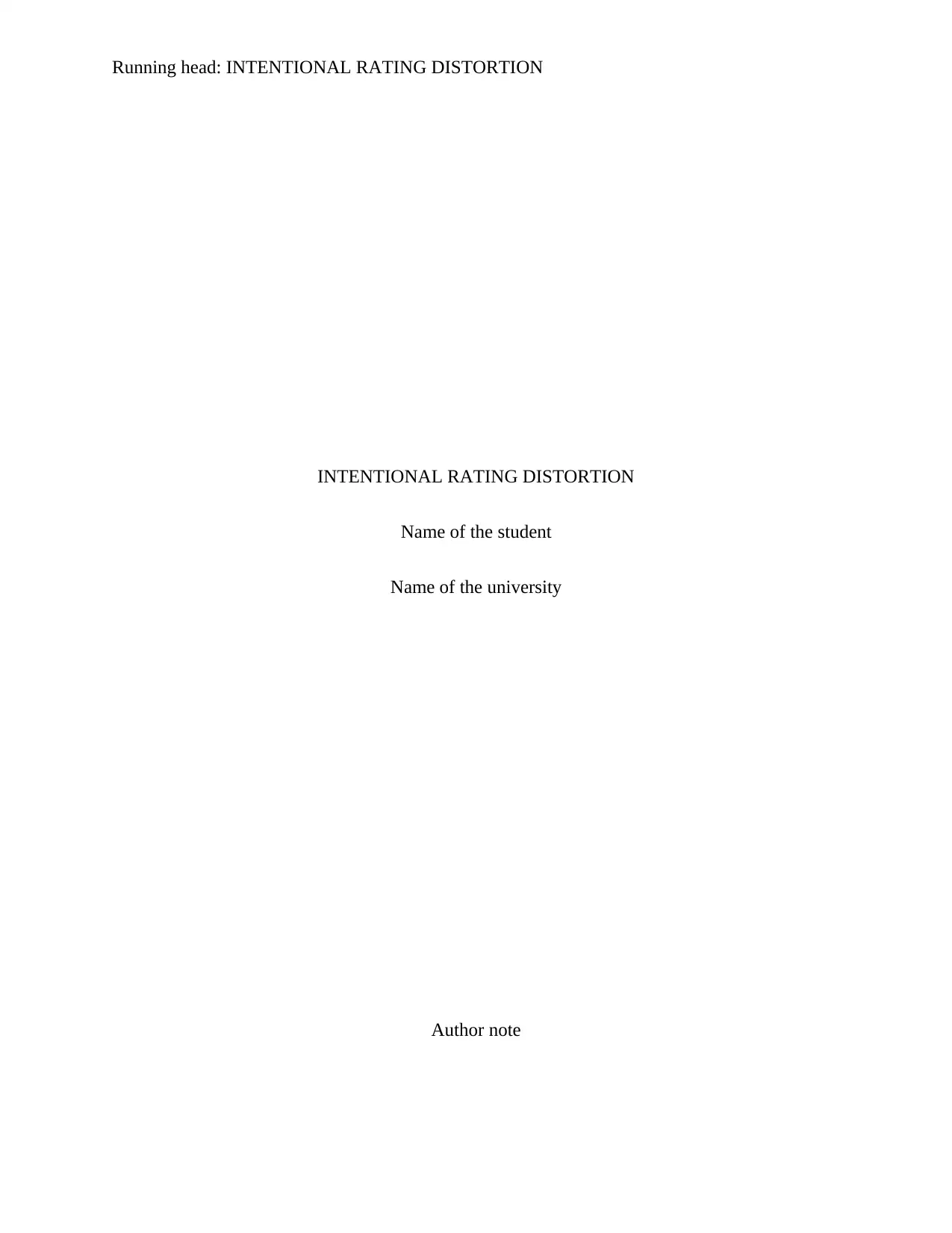
Running head: INTENTIONAL RATING DISTORTION
INTENTIONAL RATING DISTORTION
Name of the student
Name of the university
Author note
INTENTIONAL RATING DISTORTION
Name of the student
Name of the university
Author note
Paraphrase This Document
Need a fresh take? Get an instant paraphrase of this document with our AI Paraphraser
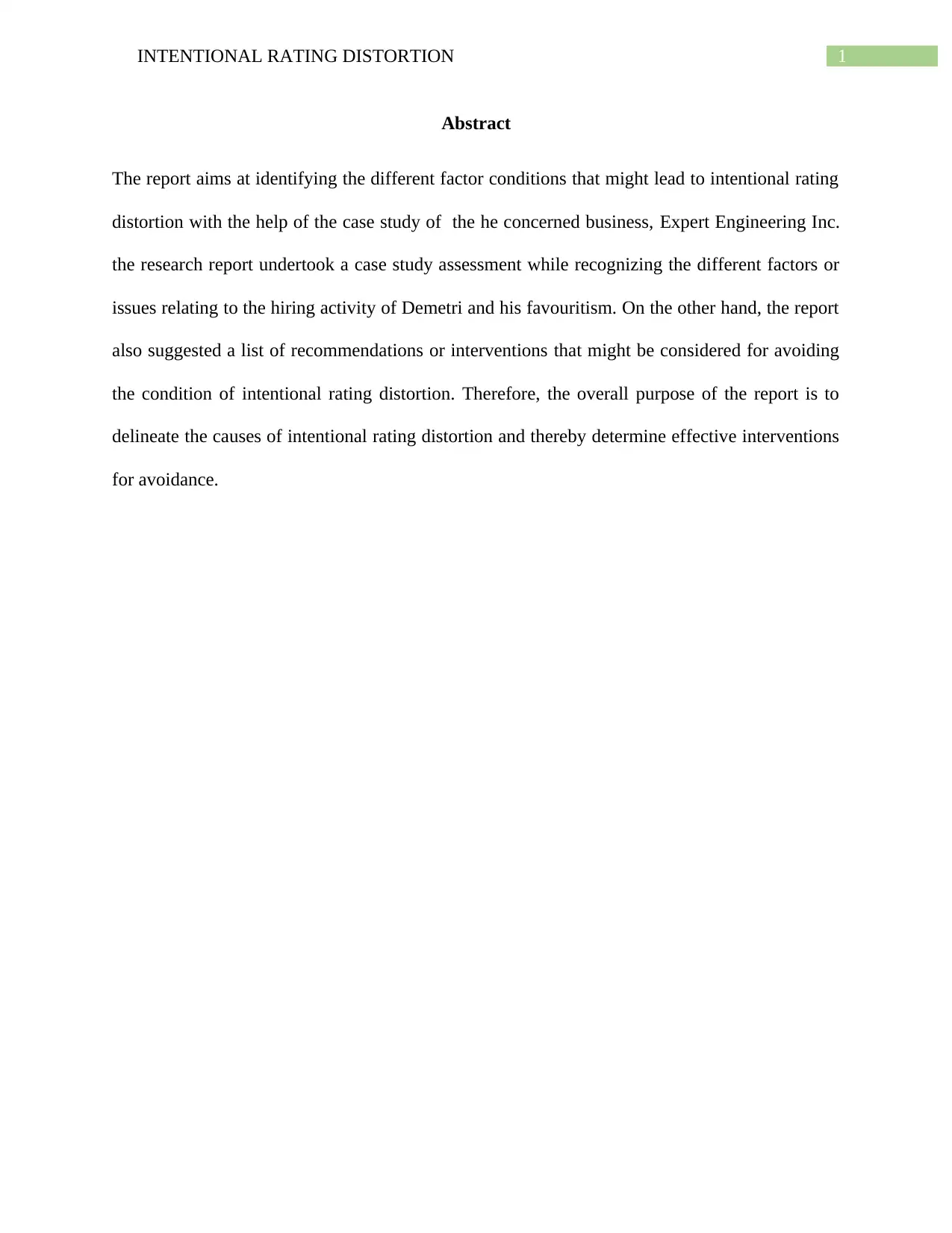
1INTENTIONAL RATING DISTORTION
Abstract
The report aims at identifying the different factor conditions that might lead to intentional rating
distortion with the help of the case study of the he concerned business, Expert Engineering Inc.
the research report undertook a case study assessment while recognizing the different factors or
issues relating to the hiring activity of Demetri and his favouritism. On the other hand, the report
also suggested a list of recommendations or interventions that might be considered for avoiding
the condition of intentional rating distortion. Therefore, the overall purpose of the report is to
delineate the causes of intentional rating distortion and thereby determine effective interventions
for avoidance.
Abstract
The report aims at identifying the different factor conditions that might lead to intentional rating
distortion with the help of the case study of the he concerned business, Expert Engineering Inc.
the research report undertook a case study assessment while recognizing the different factors or
issues relating to the hiring activity of Demetri and his favouritism. On the other hand, the report
also suggested a list of recommendations or interventions that might be considered for avoiding
the condition of intentional rating distortion. Therefore, the overall purpose of the report is to
delineate the causes of intentional rating distortion and thereby determine effective interventions
for avoidance.
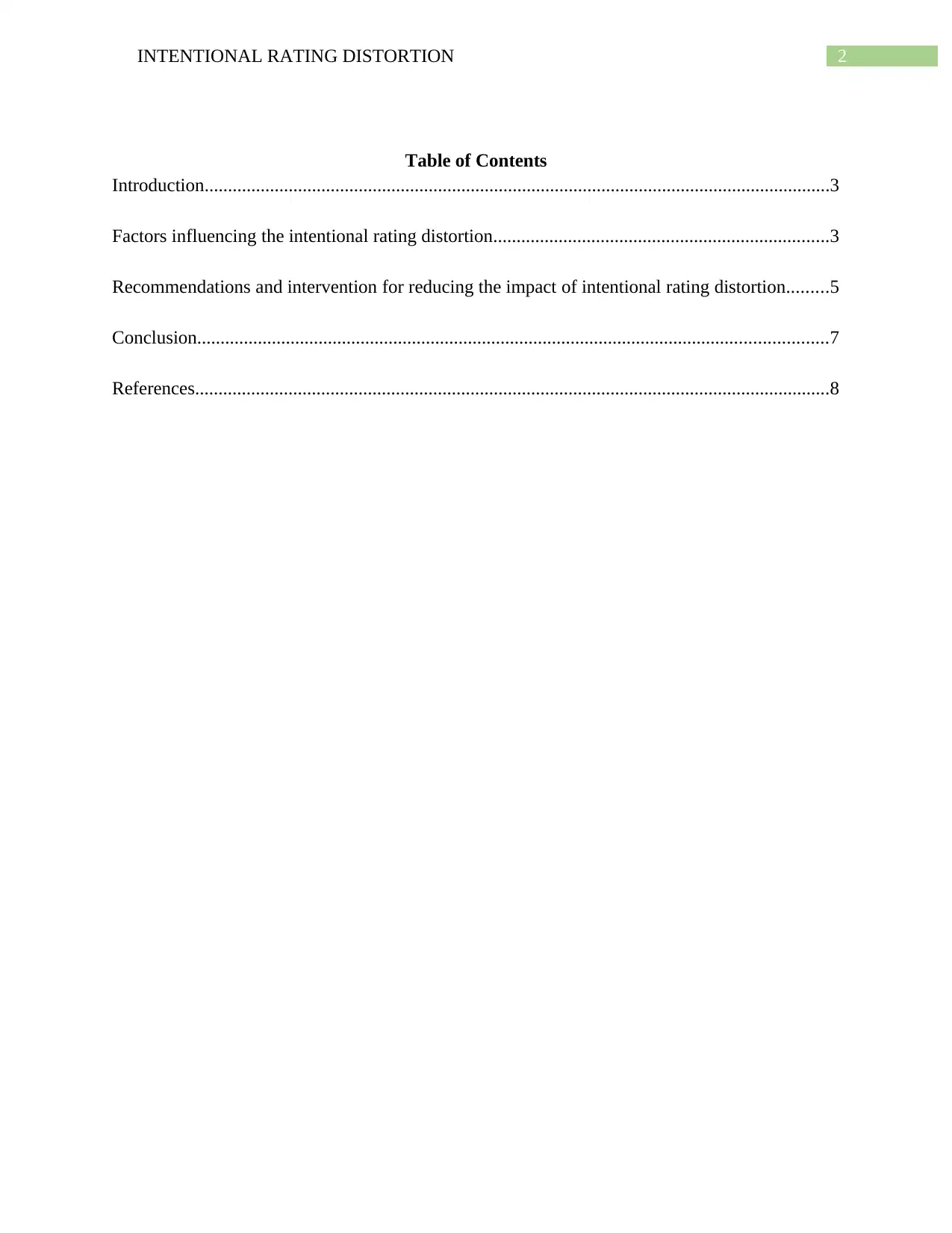
2INTENTIONAL RATING DISTORTION
Table of Contents
Introduction......................................................................................................................................3
Factors influencing the intentional rating distortion........................................................................3
Recommendations and intervention for reducing the impact of intentional rating distortion.........5
Conclusion.......................................................................................................................................7
References........................................................................................................................................8
Table of Contents
Introduction......................................................................................................................................3
Factors influencing the intentional rating distortion........................................................................3
Recommendations and intervention for reducing the impact of intentional rating distortion.........5
Conclusion.......................................................................................................................................7
References........................................................................................................................................8
⊘ This is a preview!⊘
Do you want full access?
Subscribe today to unlock all pages.

Trusted by 1+ million students worldwide
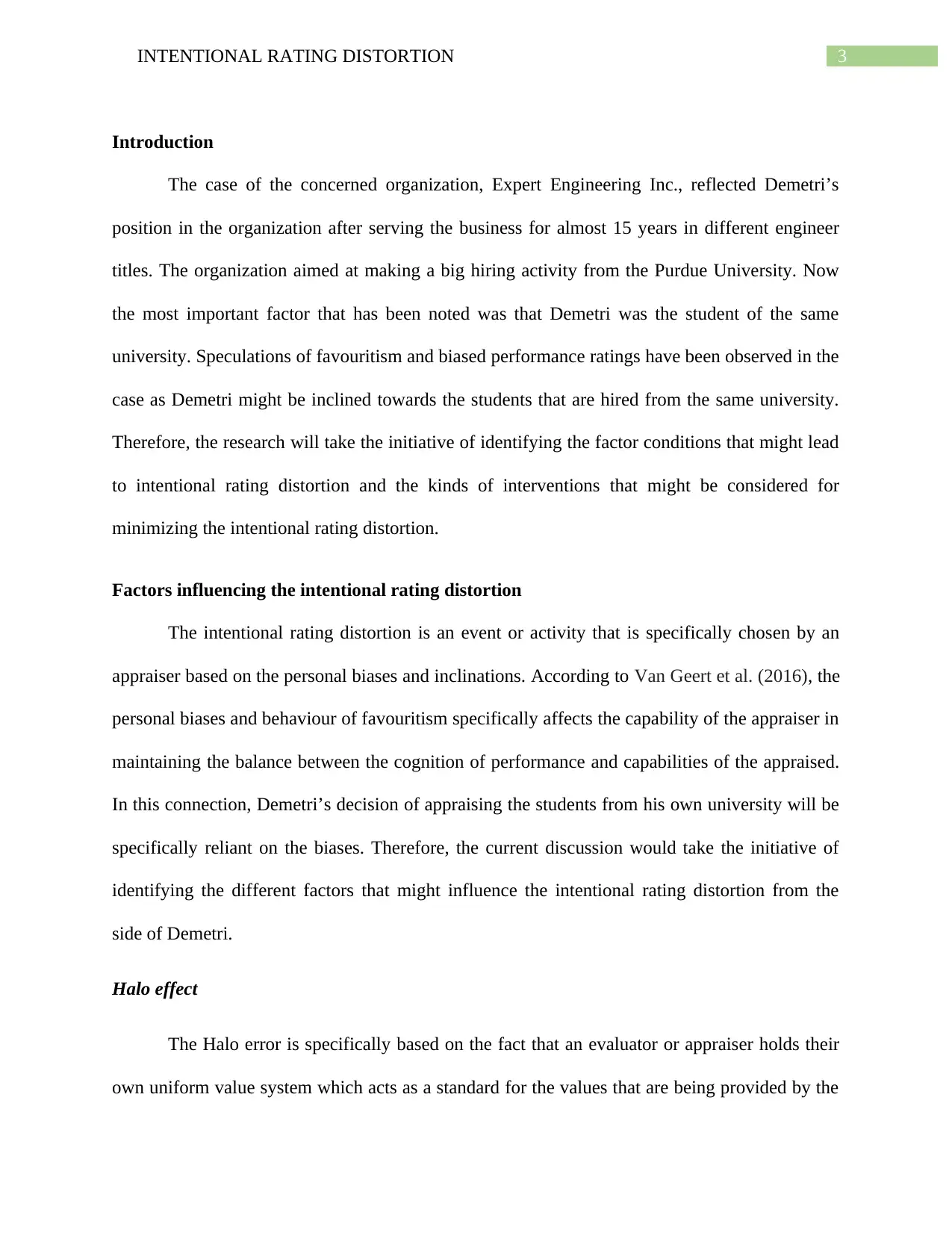
3INTENTIONAL RATING DISTORTION
Introduction
The case of the concerned organization, Expert Engineering Inc., reflected Demetri’s
position in the organization after serving the business for almost 15 years in different engineer
titles. The organization aimed at making a big hiring activity from the Purdue University. Now
the most important factor that has been noted was that Demetri was the student of the same
university. Speculations of favouritism and biased performance ratings have been observed in the
case as Demetri might be inclined towards the students that are hired from the same university.
Therefore, the research will take the initiative of identifying the factor conditions that might lead
to intentional rating distortion and the kinds of interventions that might be considered for
minimizing the intentional rating distortion.
Factors influencing the intentional rating distortion
The intentional rating distortion is an event or activity that is specifically chosen by an
appraiser based on the personal biases and inclinations. According to Van Geert et al. (2016), the
personal biases and behaviour of favouritism specifically affects the capability of the appraiser in
maintaining the balance between the cognition of performance and capabilities of the appraised.
In this connection, Demetri’s decision of appraising the students from his own university will be
specifically reliant on the biases. Therefore, the current discussion would take the initiative of
identifying the different factors that might influence the intentional rating distortion from the
side of Demetri.
Halo effect
The Halo error is specifically based on the fact that an evaluator or appraiser holds their
own uniform value system which acts as a standard for the values that are being provided by the
Introduction
The case of the concerned organization, Expert Engineering Inc., reflected Demetri’s
position in the organization after serving the business for almost 15 years in different engineer
titles. The organization aimed at making a big hiring activity from the Purdue University. Now
the most important factor that has been noted was that Demetri was the student of the same
university. Speculations of favouritism and biased performance ratings have been observed in the
case as Demetri might be inclined towards the students that are hired from the same university.
Therefore, the research will take the initiative of identifying the factor conditions that might lead
to intentional rating distortion and the kinds of interventions that might be considered for
minimizing the intentional rating distortion.
Factors influencing the intentional rating distortion
The intentional rating distortion is an event or activity that is specifically chosen by an
appraiser based on the personal biases and inclinations. According to Van Geert et al. (2016), the
personal biases and behaviour of favouritism specifically affects the capability of the appraiser in
maintaining the balance between the cognition of performance and capabilities of the appraised.
In this connection, Demetri’s decision of appraising the students from his own university will be
specifically reliant on the biases. Therefore, the current discussion would take the initiative of
identifying the different factors that might influence the intentional rating distortion from the
side of Demetri.
Halo effect
The Halo error is specifically based on the fact that an evaluator or appraiser holds their
own uniform value system which acts as a standard for the values that are being provided by the
Paraphrase This Document
Need a fresh take? Get an instant paraphrase of this document with our AI Paraphraser
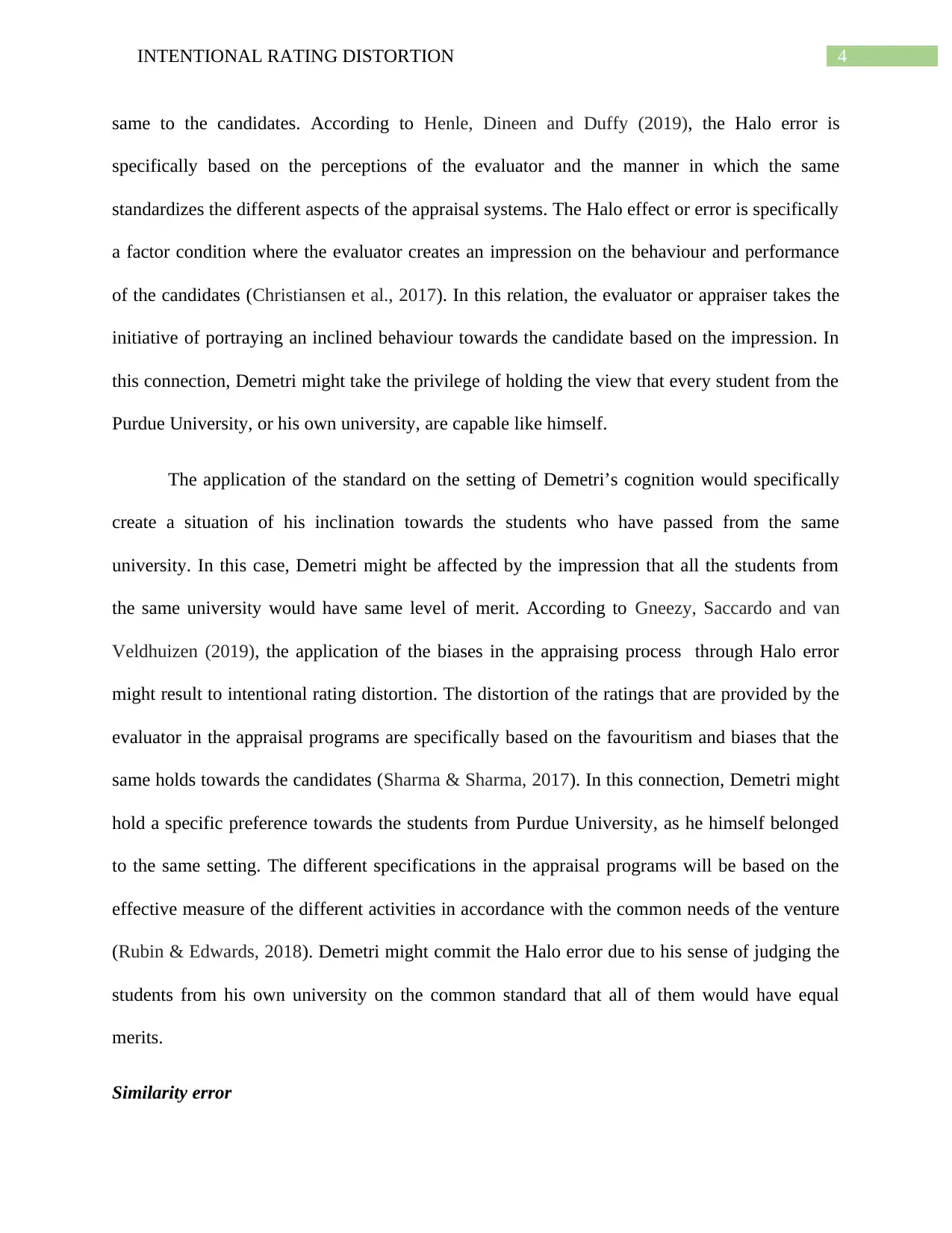
4INTENTIONAL RATING DISTORTION
same to the candidates. According to Henle, Dineen and Duffy (2019), the Halo error is
specifically based on the perceptions of the evaluator and the manner in which the same
standardizes the different aspects of the appraisal systems. The Halo effect or error is specifically
a factor condition where the evaluator creates an impression on the behaviour and performance
of the candidates (Christiansen et al., 2017). In this relation, the evaluator or appraiser takes the
initiative of portraying an inclined behaviour towards the candidate based on the impression. In
this connection, Demetri might take the privilege of holding the view that every student from the
Purdue University, or his own university, are capable like himself.
The application of the standard on the setting of Demetri’s cognition would specifically
create a situation of his inclination towards the students who have passed from the same
university. In this case, Demetri might be affected by the impression that all the students from
the same university would have same level of merit. According to Gneezy, Saccardo and van
Veldhuizen (2019), the application of the biases in the appraising process through Halo error
might result to intentional rating distortion. The distortion of the ratings that are provided by the
evaluator in the appraisal programs are specifically based on the favouritism and biases that the
same holds towards the candidates (Sharma & Sharma, 2017). In this connection, Demetri might
hold a specific preference towards the students from Purdue University, as he himself belonged
to the same setting. The different specifications in the appraisal programs will be based on the
effective measure of the different activities in accordance with the common needs of the venture
(Rubin & Edwards, 2018). Demetri might commit the Halo error due to his sense of judging the
students from his own university on the common standard that all of them would have equal
merits.
Similarity error
same to the candidates. According to Henle, Dineen and Duffy (2019), the Halo error is
specifically based on the perceptions of the evaluator and the manner in which the same
standardizes the different aspects of the appraisal systems. The Halo effect or error is specifically
a factor condition where the evaluator creates an impression on the behaviour and performance
of the candidates (Christiansen et al., 2017). In this relation, the evaluator or appraiser takes the
initiative of portraying an inclined behaviour towards the candidate based on the impression. In
this connection, Demetri might take the privilege of holding the view that every student from the
Purdue University, or his own university, are capable like himself.
The application of the standard on the setting of Demetri’s cognition would specifically
create a situation of his inclination towards the students who have passed from the same
university. In this case, Demetri might be affected by the impression that all the students from
the same university would have same level of merit. According to Gneezy, Saccardo and van
Veldhuizen (2019), the application of the biases in the appraising process through Halo error
might result to intentional rating distortion. The distortion of the ratings that are provided by the
evaluator in the appraisal programs are specifically based on the favouritism and biases that the
same holds towards the candidates (Sharma & Sharma, 2017). In this connection, Demetri might
hold a specific preference towards the students from Purdue University, as he himself belonged
to the same setting. The different specifications in the appraisal programs will be based on the
effective measure of the different activities in accordance with the common needs of the venture
(Rubin & Edwards, 2018). Demetri might commit the Halo error due to his sense of judging the
students from his own university on the common standard that all of them would have equal
merits.
Similarity error
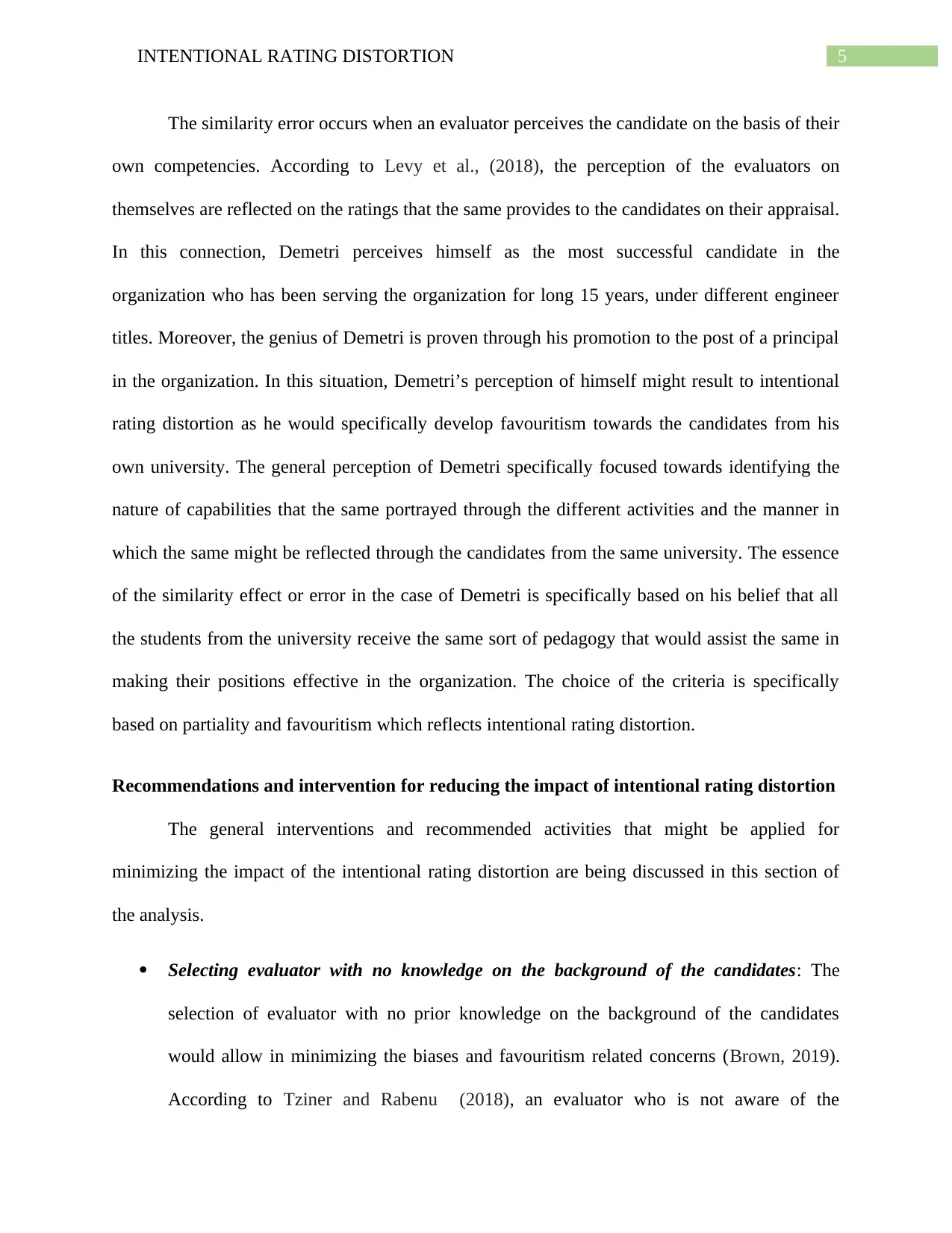
5INTENTIONAL RATING DISTORTION
The similarity error occurs when an evaluator perceives the candidate on the basis of their
own competencies. According to Levy et al., (2018), the perception of the evaluators on
themselves are reflected on the ratings that the same provides to the candidates on their appraisal.
In this connection, Demetri perceives himself as the most successful candidate in the
organization who has been serving the organization for long 15 years, under different engineer
titles. Moreover, the genius of Demetri is proven through his promotion to the post of a principal
in the organization. In this situation, Demetri’s perception of himself might result to intentional
rating distortion as he would specifically develop favouritism towards the candidates from his
own university. The general perception of Demetri specifically focused towards identifying the
nature of capabilities that the same portrayed through the different activities and the manner in
which the same might be reflected through the candidates from the same university. The essence
of the similarity effect or error in the case of Demetri is specifically based on his belief that all
the students from the university receive the same sort of pedagogy that would assist the same in
making their positions effective in the organization. The choice of the criteria is specifically
based on partiality and favouritism which reflects intentional rating distortion.
Recommendations and intervention for reducing the impact of intentional rating distortion
The general interventions and recommended activities that might be applied for
minimizing the impact of the intentional rating distortion are being discussed in this section of
the analysis.
Selecting evaluator with no knowledge on the background of the candidates: The
selection of evaluator with no prior knowledge on the background of the candidates
would allow in minimizing the biases and favouritism related concerns (Brown, 2019).
According to Tziner and Rabenu (2018), an evaluator who is not aware of the
The similarity error occurs when an evaluator perceives the candidate on the basis of their
own competencies. According to Levy et al., (2018), the perception of the evaluators on
themselves are reflected on the ratings that the same provides to the candidates on their appraisal.
In this connection, Demetri perceives himself as the most successful candidate in the
organization who has been serving the organization for long 15 years, under different engineer
titles. Moreover, the genius of Demetri is proven through his promotion to the post of a principal
in the organization. In this situation, Demetri’s perception of himself might result to intentional
rating distortion as he would specifically develop favouritism towards the candidates from his
own university. The general perception of Demetri specifically focused towards identifying the
nature of capabilities that the same portrayed through the different activities and the manner in
which the same might be reflected through the candidates from the same university. The essence
of the similarity effect or error in the case of Demetri is specifically based on his belief that all
the students from the university receive the same sort of pedagogy that would assist the same in
making their positions effective in the organization. The choice of the criteria is specifically
based on partiality and favouritism which reflects intentional rating distortion.
Recommendations and intervention for reducing the impact of intentional rating distortion
The general interventions and recommended activities that might be applied for
minimizing the impact of the intentional rating distortion are being discussed in this section of
the analysis.
Selecting evaluator with no knowledge on the background of the candidates: The
selection of evaluator with no prior knowledge on the background of the candidates
would allow in minimizing the biases and favouritism related concerns (Brown, 2019).
According to Tziner and Rabenu (2018), an evaluator who is not aware of the
⊘ This is a preview!⊘
Do you want full access?
Subscribe today to unlock all pages.

Trusted by 1+ million students worldwide
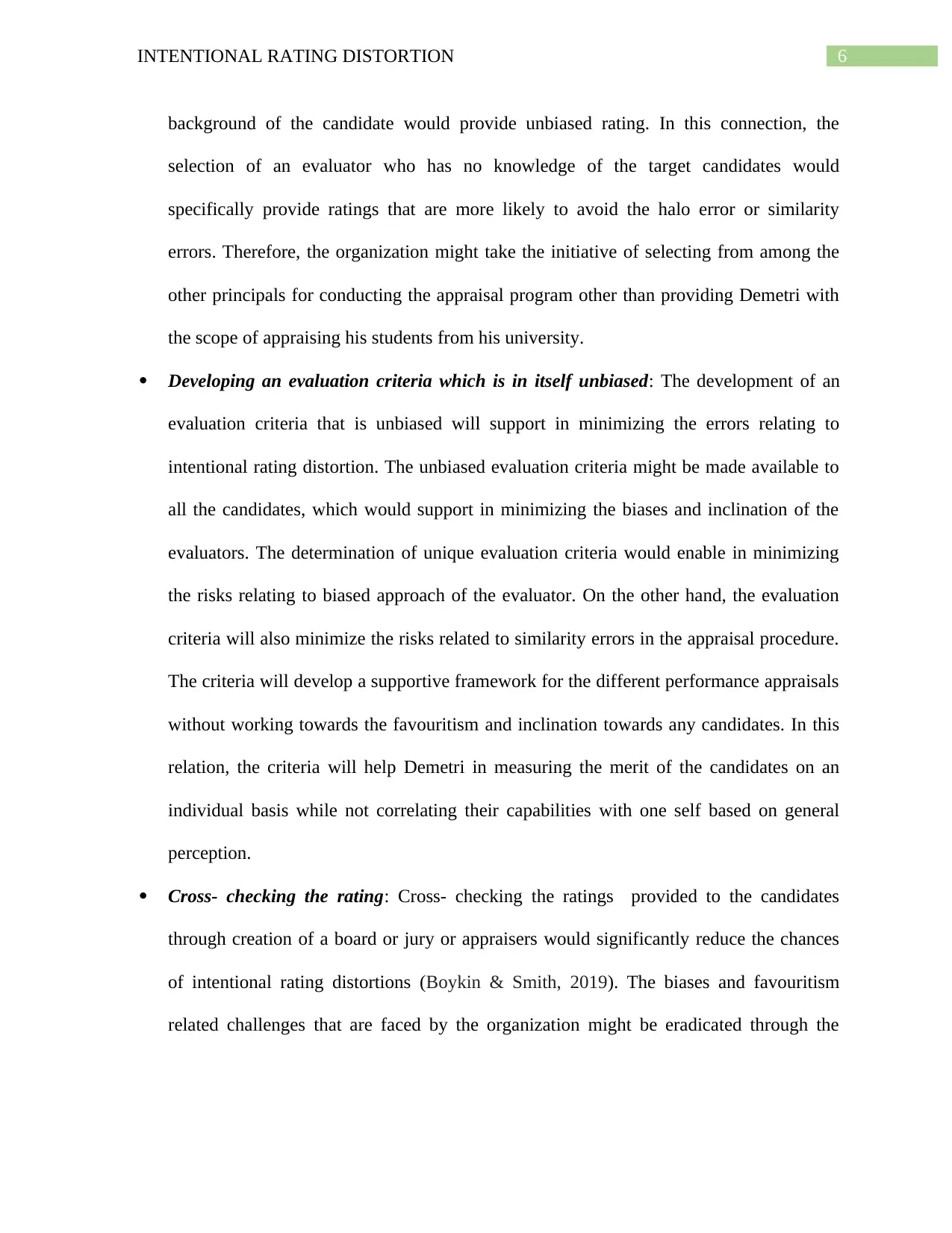
6INTENTIONAL RATING DISTORTION
background of the candidate would provide unbiased rating. In this connection, the
selection of an evaluator who has no knowledge of the target candidates would
specifically provide ratings that are more likely to avoid the halo error or similarity
errors. Therefore, the organization might take the initiative of selecting from among the
other principals for conducting the appraisal program other than providing Demetri with
the scope of appraising his students from his university.
Developing an evaluation criteria which is in itself unbiased: The development of an
evaluation criteria that is unbiased will support in minimizing the errors relating to
intentional rating distortion. The unbiased evaluation criteria might be made available to
all the candidates, which would support in minimizing the biases and inclination of the
evaluators. The determination of unique evaluation criteria would enable in minimizing
the risks relating to biased approach of the evaluator. On the other hand, the evaluation
criteria will also minimize the risks related to similarity errors in the appraisal procedure.
The criteria will develop a supportive framework for the different performance appraisals
without working towards the favouritism and inclination towards any candidates. In this
relation, the criteria will help Demetri in measuring the merit of the candidates on an
individual basis while not correlating their capabilities with one self based on general
perception.
Cross- checking the rating: Cross- checking the ratings provided to the candidates
through creation of a board or jury or appraisers would significantly reduce the chances
of intentional rating distortions (Boykin & Smith, 2019). The biases and favouritism
related challenges that are faced by the organization might be eradicated through the
background of the candidate would provide unbiased rating. In this connection, the
selection of an evaluator who has no knowledge of the target candidates would
specifically provide ratings that are more likely to avoid the halo error or similarity
errors. Therefore, the organization might take the initiative of selecting from among the
other principals for conducting the appraisal program other than providing Demetri with
the scope of appraising his students from his university.
Developing an evaluation criteria which is in itself unbiased: The development of an
evaluation criteria that is unbiased will support in minimizing the errors relating to
intentional rating distortion. The unbiased evaluation criteria might be made available to
all the candidates, which would support in minimizing the biases and inclination of the
evaluators. The determination of unique evaluation criteria would enable in minimizing
the risks relating to biased approach of the evaluator. On the other hand, the evaluation
criteria will also minimize the risks related to similarity errors in the appraisal procedure.
The criteria will develop a supportive framework for the different performance appraisals
without working towards the favouritism and inclination towards any candidates. In this
relation, the criteria will help Demetri in measuring the merit of the candidates on an
individual basis while not correlating their capabilities with one self based on general
perception.
Cross- checking the rating: Cross- checking the ratings provided to the candidates
through creation of a board or jury or appraisers would significantly reduce the chances
of intentional rating distortions (Boykin & Smith, 2019). The biases and favouritism
related challenges that are faced by the organization might be eradicated through the
Paraphrase This Document
Need a fresh take? Get an instant paraphrase of this document with our AI Paraphraser
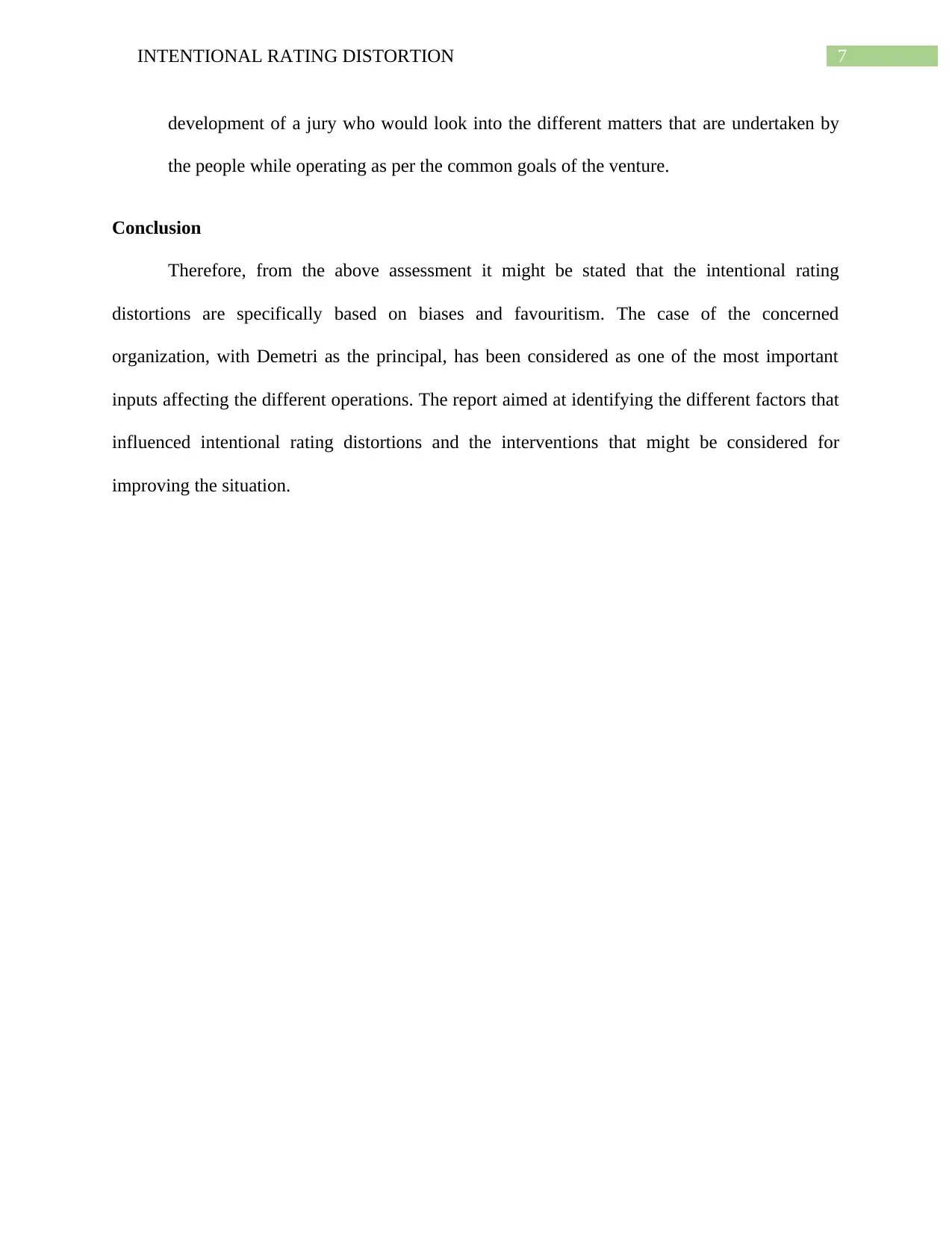
7INTENTIONAL RATING DISTORTION
development of a jury who would look into the different matters that are undertaken by
the people while operating as per the common goals of the venture.
Conclusion
Therefore, from the above assessment it might be stated that the intentional rating
distortions are specifically based on biases and favouritism. The case of the concerned
organization, with Demetri as the principal, has been considered as one of the most important
inputs affecting the different operations. The report aimed at identifying the different factors that
influenced intentional rating distortions and the interventions that might be considered for
improving the situation.
development of a jury who would look into the different matters that are undertaken by
the people while operating as per the common goals of the venture.
Conclusion
Therefore, from the above assessment it might be stated that the intentional rating
distortions are specifically based on biases and favouritism. The case of the concerned
organization, with Demetri as the principal, has been considered as one of the most important
inputs affecting the different operations. The report aimed at identifying the different factors that
influenced intentional rating distortions and the interventions that might be considered for
improving the situation.

8INTENTIONAL RATING DISTORTION
References
Boykin, C. M., & Smith, C. R. (2019). Motivations to Control Prejudice Bias Performance
Feedback in Developmental Relationships. Personnel Assessment and Decisions, 5(2), 8.
Brown, M. (2019). Understanding Performance Appraisal: Supervisory and Employee
Perspectives. The SAGE Handbook of Human Resource Management, 195.
Christiansen, N. D., Robie, C., Burns, G. N., & Speer, A. B. (2017). Using item-level covariance
to detect response distortion on personality measures. Human Performance, 30(2-3), 116-
134.
Gneezy, U., Saccardo, S., & van Veldhuizen, R. (2019). Bribery: Behavioral drivers of distorted
decisions. Journal of the European Economic Association, 17(3), 917-946.
Henle, C. A., Dineen, B. R., & Duffy, M. K. (2019). Assessing intentional resume deception:
Development and nomological network of a resume fraud measure. Journal of Business
and Psychology, 34(1), 87-106.
Levy, P. E., Cavanaugh, C. M., Frantz, N. B., Borden, L. A., & Roberts, A. (2018). Revisiting
the social context of performance management: Performance appraisal effectiveness.
Rubin, E. V., & Edwards, A. (2018). The performance of performance appraisal systems:
understanding the linkage between appraisal structure and appraisal discrimination
complaints. The International Journal of Human Resource Management, 1-20.
Sharma, A., & Sharma, T. (2017). HR analytics and performance appraisal system. Management
Research Review.
References
Boykin, C. M., & Smith, C. R. (2019). Motivations to Control Prejudice Bias Performance
Feedback in Developmental Relationships. Personnel Assessment and Decisions, 5(2), 8.
Brown, M. (2019). Understanding Performance Appraisal: Supervisory and Employee
Perspectives. The SAGE Handbook of Human Resource Management, 195.
Christiansen, N. D., Robie, C., Burns, G. N., & Speer, A. B. (2017). Using item-level covariance
to detect response distortion on personality measures. Human Performance, 30(2-3), 116-
134.
Gneezy, U., Saccardo, S., & van Veldhuizen, R. (2019). Bribery: Behavioral drivers of distorted
decisions. Journal of the European Economic Association, 17(3), 917-946.
Henle, C. A., Dineen, B. R., & Duffy, M. K. (2019). Assessing intentional resume deception:
Development and nomological network of a resume fraud measure. Journal of Business
and Psychology, 34(1), 87-106.
Levy, P. E., Cavanaugh, C. M., Frantz, N. B., Borden, L. A., & Roberts, A. (2018). Revisiting
the social context of performance management: Performance appraisal effectiveness.
Rubin, E. V., & Edwards, A. (2018). The performance of performance appraisal systems:
understanding the linkage between appraisal structure and appraisal discrimination
complaints. The International Journal of Human Resource Management, 1-20.
Sharma, A., & Sharma, T. (2017). HR analytics and performance appraisal system. Management
Research Review.
⊘ This is a preview!⊘
Do you want full access?
Subscribe today to unlock all pages.

Trusted by 1+ million students worldwide

9INTENTIONAL RATING DISTORTION
Tziner, A., & Rabenu, E. (2018). The performance appraisal system (PAS). In Improving
Performance Appraisal at Work. Edward Elgar Publishing.
Van Geert, E., Orhon, A., Cioca, I. A., Mamede, R., Golušin, S., Hubená, B., & Morillo, D.
(2016). Study protocol on intentional distortion in personality assessment: Relationship
with test format, culture, and cognitive ability. Frontiers in psychology, 7, 933.
Tziner, A., & Rabenu, E. (2018). The performance appraisal system (PAS). In Improving
Performance Appraisal at Work. Edward Elgar Publishing.
Van Geert, E., Orhon, A., Cioca, I. A., Mamede, R., Golušin, S., Hubená, B., & Morillo, D.
(2016). Study protocol on intentional distortion in personality assessment: Relationship
with test format, culture, and cognitive ability. Frontiers in psychology, 7, 933.
1 out of 10
Related Documents
Your All-in-One AI-Powered Toolkit for Academic Success.
+13062052269
info@desklib.com
Available 24*7 on WhatsApp / Email
![[object Object]](/_next/static/media/star-bottom.7253800d.svg)
Unlock your academic potential
Copyright © 2020–2025 A2Z Services. All Rights Reserved. Developed and managed by ZUCOL.





